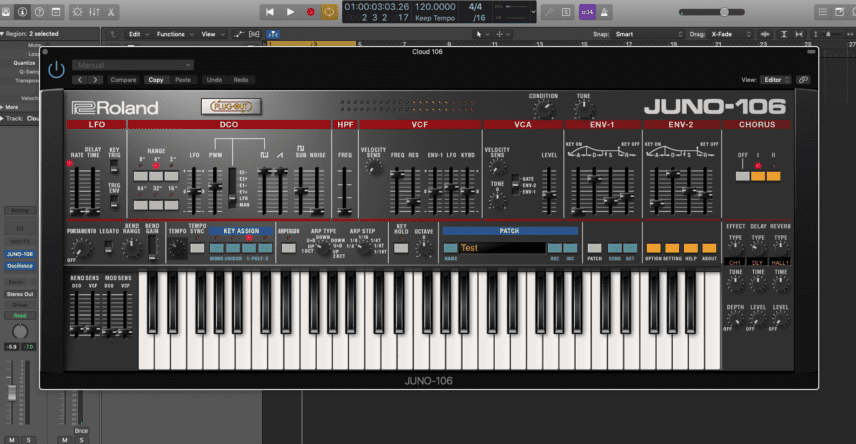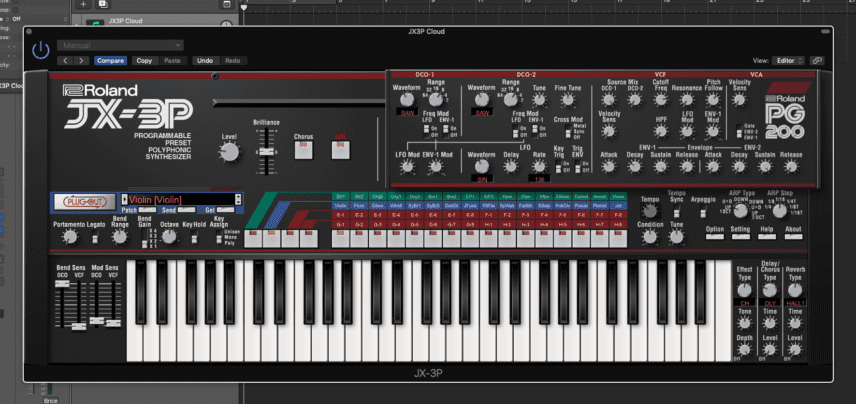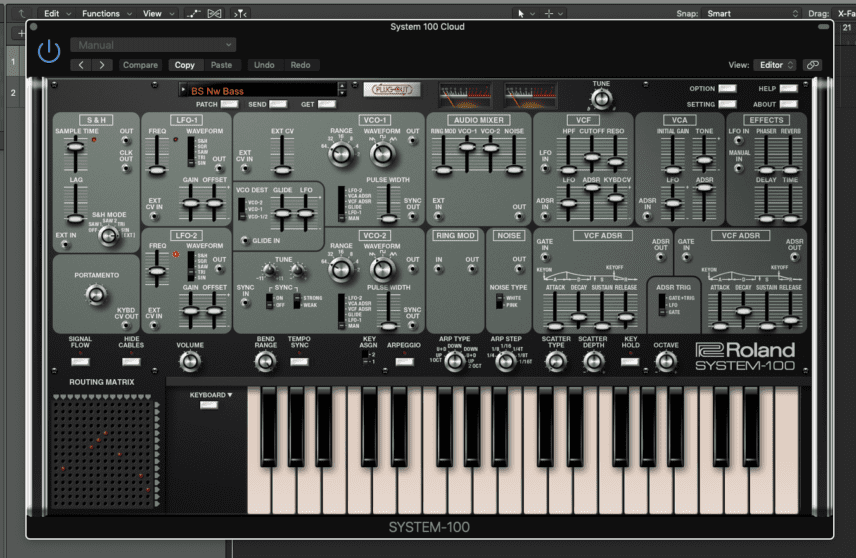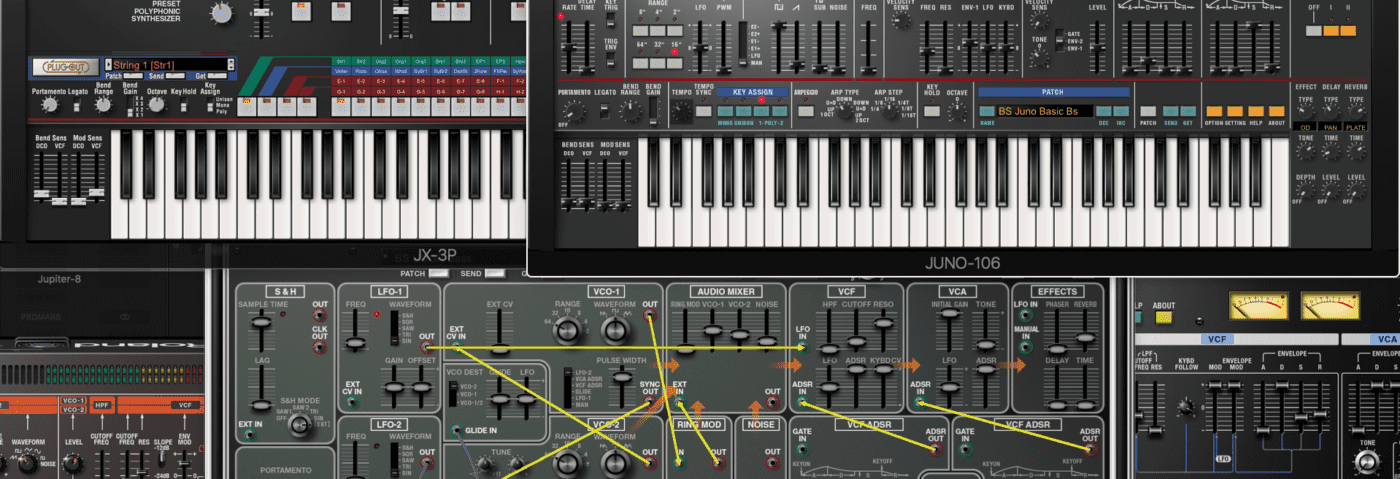Adam Douglas finds out just how analogue the Roland Cloud is.
Released in 2017, the Roland Cloud is something of a greatest hits collection of software instruments for the venerable Japanese musical instrument company. With plugins covering synthesizers, drum machines, and expansion boards, there’s a little bit of everything. It’s the recreations of vintage analogue gear, however, that is the real selling point for the subscription service. But just how analogue are these modern software versions? We took three of the software synths — Juno-106, JX-3P, and System-100 — and went head to head with the original hardware in terms of features, architecture, and of course sound.
To compare hardware and software, we used similar settings and gain levels. Please do keep in mind though that vintage gear can be temperamental, and even identical units will have varying degrees of sonic differences due to the aging of components, repairs, etc.
General Features
The analogue recreations in the Roland Cloud are not just slavish imitations of the original gear but true updates, designed with the modern musician in mind. Mostly every synth has an arpeggiator, whether the original did or not, and keeping in line with the need to work with the System-1 and System-8 hardware as “plugouts”, they all follow a similar architecture. They also include effects, which the 1970s and ‘80s synths definitely did not. Many synths also have two envelope sections as well as filter and VCA trim knobs.
While not ubiquitous across all the instruments, many include a Condition knob at the top. Turning it to the right (the + direction) will artificially “age” the sound, adding “slight discrepancies” to the sound, according to the manual for the TB-303. Cranking it completely clockwise can be almost too extreme, while fully anticlockwise will make it more “perfect” sounding. In other words, less like a hardware synthesizer and more like a plugin.
Juno-106

The 1984 Juno-106 is a workhorse of a synth that’s found favor with dance music producers, among others, for its ability to crank out gorgeous pads, silky leads, and punchy bass with ease (10 more reasons why the Roland Juno is the greatest synthesizer of all time). Part of its charm lies in its ease of use: with just one oscillator and basic modulation options, it’s easy to dial in extremely useful sounds without trying very hard. The Cloud version ups its capabilities considerably, stretching the octave range from the original 4 to 16 feet to a surprising 2 to 64 feet and replacing the oscillator waveshape (square and sawtooth) buttons with blendable sliders. All well and good, but how does it sound? In a word: astonishing. Going head to head with the hardware, it was almost impossible to tell them apart at times. The Cloud version of the 106 is a triumph of analogue modeling.
Here is the hardware Juno-106 playing a high pad sound.
And here is the Roland Cloud version of the Juno-106 recreating the same sound.
JX-3P

Released in 1983, the 6-voice polyphonic JX-3P is something of an underrated Roland synth, but look beyond its preset configuration and color scheme and you’ll find a unique analogue poly that’s well-suited to pads and lead sounds. The Cloud version goes a long way towards addressing many of the drawbacks of the original synth: namely a lack of knobs (unless you ponied up for the separate PG-200 editor, here available with the push of a button). With front-panel filter, LFO, and modulation controls, plus the same extended features found on the other plugout synths, the JX-3P can now play with the big boys. While not as deeply analogue-sounding as the Juno-106 plugin, this JX-3P sounds great, with the same shimmering high-end. Unlike the Juno though, which models the famous chorus perfectly, the JX-3P uses a stock chorus, not the original. And while it’s a lovely chorus indeed, airy and swirly, it does sound different from the hardware.
The hardware JX-3P playing the Synth Brass 1 preset.
The same preset, this time on the Roland Cloud JX-3P.
System-100

The System-100 (1975) was a semi-modular set of units that combined, Voltron-style, into one complete system. It was comprised of a single-oscillator monosynth and expander, a mixer, a step sequencer, and a set of speakers. The Cloud version combines the synth and expander into one instrument, sadly doing away with the step sequencer yet adding a whole host of new features. The most striking addition is the EMS VCS 3-style pin matrix, which works in tandem with the virtual cables that can be patched into the front panel, making it a sound designer’s dream come true. The original System-100 is a beast of a monosynth, with a depth and presence that is formidable even when compared to other analogue hardware synthesizers. The Cloud version captures this presence remarkably well, bringing it into the 21st century with convenient features while never sacrificing what made the original so special.
hardware synthesizers. The Cloud version captures this presence remarkably well, bringing it into the 21st century with convenient features while never sacrificing what made the original so special.
The hardware System 100 pumping out a sawtooth bassline.
The software version of the System 100 cranking out the same sawtooth bassline.
In Summary
The Roland Cloud held its own remarkably well when taken head to head with the comparable hardware. Whether you think a subscription model is for you is something you’ll have to decide, but in terms of how “analogue” it sounds, it really is phenomenal. And, given the extended features and ease of use, even owners of the original hardware may find it worthwhile. Of course, this level of analogue modeling comes at a price—a significant hit to the CPU—but not unduly, and in line with what we might expect from similarly deep plugins from other manufacturers. Given the sheer amount of famous instruments available, not to mention the expansion cards, sample packs, and other extras, the Roland Cloud is really a must-have for anyone with the budget.
Roland Cloud is available in a number of subscription price points, including monthly for £18.50, with a one-year subscription costing £185.00. For more information visit the Roland Cloud website.
